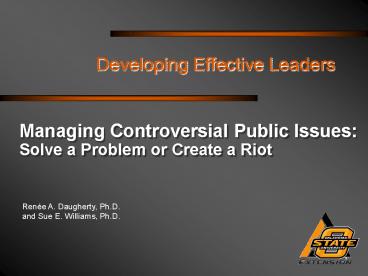Developing Effective Leaders - PowerPoint PPT Presentation
1 / 23
Title:
Developing Effective Leaders
Description:
Developing Effective Leaders Managing Controversial Public Issues: Solve a Problem or Create a Riot * In this session, you will learn to: Identify elements of a ... – PowerPoint PPT presentation
Number of Views:62
Avg rating:3.0/5.0
Title: Developing Effective Leaders
1
Developing Effective Leaders
- Managing Controversial Public IssuesSolve a
Problem or Create a Riot
2
In this session, you will learn to
- Identify elements of a community issue.
- Distinguish between myths, facts, values.
- Appreciate importance of naming issues.
- Understand the elements of issue framing.
- Understand alternatives and consequences.
- Recognize styles of issue resolution.
- Identify roles that leaders can perform.
3
Elements of Public Issue
- Is the problem a problem or a solution being
promoted? - Is there controversy?
- Is it a public problem?
- What are the multiple sides to the issue?
- Can public discussion offer a solution?
- Are people ready to discuss? Is there a window
of opportunity for resolution? - Are there resources for resolution?
- Are you willing able to be neutral and
objective?
4
Potential Controversy
- Quality of life/standard of living
- Personal health/safety
- Environmental risk
- Justice/equality
- Role of government
5
The Public Decision-Making Process
6
Activity Who Gets the Heart?
22-year-old Brazilian soccer star
37-year old single mother on welfare
53-year-old Nobel Prize winning scientist on the
verge of discovering a cure for Heart Disease
66-year-old retired woman with 17 grandchildren
7
Approaches to Problem Solving
- Pro vs. Con
- Divisive and destructive
- Alternatives and Consequences
- Cohesive and constructive
8
Styles of Issue ResolutionTraditional Issue
Based
- Principles
- Assumptions
- Steps
- Techniques
9
Styles of Issue Resolution- PRINCIPLES -
Traditional Issue-based
10
Styles of Issue Resolution- ASSUMPTIONS -
Traditional Issue-based
11
Styles of Issue Resolution- STEPS -
Traditional Issue-based
12
Styles of Issue Resolution- TECHNIQUES -
Traditional Issue-based
13
Naming the Issue
- Reflect peoples concerns
- Use public terms
- Reflect different perspectives and experiences
14
Naming the Issue Examples
- Divisive
- Public School Consolidation
- Government Health Care
- Abortion Family Planning
- Cohesive
- Improving Educational Opportunities for Public
School Youth - Improving Access to Health Care
- Preventing Teen Pregnancy
15
Framing an Issuefor Public Decision Making
- Pulling together peoples concerns and
perspectives on an issue to create a framework in
which the community can make choices about how to
act.
16
Issue Frameworks
- Frameworks can be used in many ways
- Articles in newspapers and on web sites
- Public deliberative forums
- Town hall meetings
- Brochures, flyers and handouts
- Speeches and public commentary
- Media interviews
17
Context for Framing Issues
- Be sensitive to
- Perceived concerns
- Stakeholders
- Include affected groups when working to frame the
issue.
18
Goals for Issue Framing
- Making choices
- Understanding underlying concerns
- Common ground
- Meaningful engagement
- Understanding without oversimplifying
- Citizen empowerment
- Problem-solving skills
- Improving the quality of public talk
- Broad range of views
19
Steps in Issue Framing
- Identify the issue
- Research the issue
- Name the issue in public terms
- Identify concerns
- Identify possible actions
- Cluster actions into policy directions
- Identify alternatives and consequences
- Identify potential trade-offs
20
Attributes of a Successful Issue Framework
- Based on a problem suitable for public
deliberation and decision making. - Reflects input from a wide range of community
perspectives. - Uses tension/dilemmas to stimulate thoughtful
consideration of policy approaches.
21
Roles for Community Leaders
- Forecaster or Futurist
- Advisor or Consultant
- Framework Developer
- Facilitator
- Information Provider
- Project Developer
22
Top 10 Actions forSolving Public Problems
- Tell it like it is
- Be available
- Offer predictions to challenge peoples thinking
- Admit mistakes
- Trust the people
- Get acquainted with other leaders
- Capture the teachable moment
- Do your homework
- Work within the system
- Be objective
23
Final Thought
Youre either part of the solution or part of
the problem. Eldridge Cleaver































